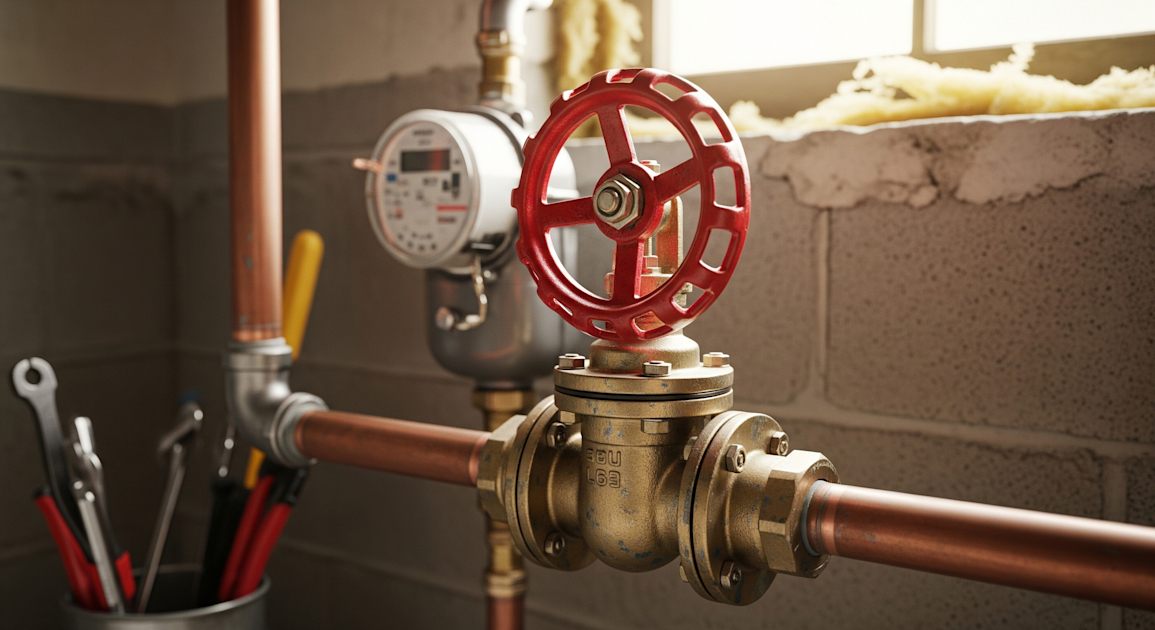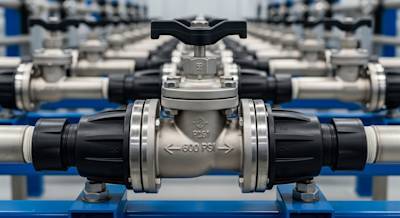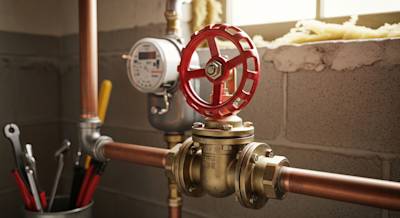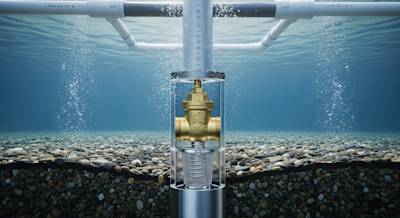Introduction to Gate Valves
Commonly used in various industries, gate valves play an essential role in controlling the flow of a liquid or gas. These valves have earned widespread acknowledgment, thanks to their remarkable features, including reliability, efficiency, and durability. Before discussing the components, uses, and kinds of gate valves, let us understand the basics.
What is a Gate Valve?
A gate valve, also known as a sluice valve, is a valve that opens by lifting a barrier (gate) out of the way of the fluid. When opened, the gate valve design prevents any obstruction in the flow path, resulting in very low friction loss.
Components of a Gate Valve
Gate valves are composed of numerous components; each plays a key role in its functionality. Here's a brief explanation of each part:
- Body: The main structure holding all parts together, usually made from durable materials like cast iron, alloy steel, forged steel, or stainless steel.
- Gate: The disc or wedge is an essential part of a gate valve – it opens or closes to control the fluid flow.
- Stem: The component responsible for moving the gate vertically – it links the handwheel to the gate.
- Bonnet: It provides a leakproof closure for the body, often bolted, screwed, or welded in place.
- Handwheel: The controlling part of the gate valve, responsible for opening and closing the gate.
- Seat: Seats can be integral with the body, or they can be connected. They form the sealing surface with the disc when the valve is closed.
Types of Gate Valves
Gate valves come in various types, each having its distinct features and uses. The three main types are:
- Parallel Gate Valve: Features a flat disc gate between two parallel seats, often used when a straight-line fluid flow is required.
- Wedge Gate Valve: Consists of two inclined seats and a slightly mismatched inclined gate for tight seals.
- Knife Gate Valve: Features a thin gate that cuts through heavy liquids, making it suitable for slurry and wastewater treatment applications.
Gate Valve Applications
Due to the wide variety of gate valve types and designs, they have found usage across many industries. Let's review some common applications:
- Oil and Gas: The industry employs gate valves for virtually all on-off valve applications to handle heavy oil flow.
- Wastewater Treatment: Knife gate valves are employed for slurry handling.
- Manufacturing: Gate valves control substance flow in various manufacturing processes.
- Pipelines: Large-diameter pipelines use gate valves as on-off valves and occasionally for throttling purposes.
The Working Principle of a Gate Valve
Gate valves operate by lifting a rectangular or circular gate out of the fluid's path. The sealing surfaces between the gate and seats are flat, allowing gate valves to be installed in both directions; they are bi-directional. This means medium pressure from any side can be stopped.
Maintenance of Gate Valves
For ensuring the longevity and efficiency of gate valves, regular maintenance is crucial. A few important maintenance steps are:
- Regular Inspection: This can help to detect any minor issues before they escalate into significant problems.
- Timely Repair and Replacement: If a faulty component is identified, it should be repaired or replaced promptly.
- Use of Quality Lubricants: Lubricating moving parts in a gate valve periodically can ensure their smooth functioning and prevent rusting.
- Dealing with Leakage: Any leakage in a gate valve should be addressed immediately.
Frequently Asked Questions about Gate Valve
Why are gate valves commonly used in pipeline applications?
Due to their superior ability to cut through liquids, gate valves are widely used in pipeline applications. With their 'gate-like' mechanism, these valves ensure unrestricted/uninterrupted flow of the liquid. They showcase remarkable shutoff capabilities, which allow the smooth regulation of thick media without damaging the valve.
How does a gate valve function?
A gate valve functions by lifting a round or rectangular gate/wedge out of the fluid's path. When the handle-wheel is turned and moves upwards, the gate is lifted fully into the bonnet, making a path for the flow. When in the 'closed' position, the disc or gate blocks the flow entirely.
How are the construction materials chosen for a gate valve?
The selection of construction materials for a gate valve depends largely on its application. Typically, considerations include the valve's exposure to temperature extremes, chemical or corrosive substances, and the pressures it will have to withstand. Common materials used in gate valve construction include brass, bronze, iron, stainless steel, plastic, and other alloys.
What's the difference between a gate valve and a globe valve?
While both gate and globe valves are used to control fluid flow, their designs and functions are different. A gate valve is ideal for either fully open or fully closed service and ensures minimal pressure loss. On the other hand, a globe valve is used for throttling flow control. Globe valves have a spherical body and are better suited to regular on/off, flow control, and shut off services.
What is a non-rising stem gate valve?
In a non-rising stem gate valve, the stem moves up and down to open and close the valve, but doesn’t rise or lower concurrently with the gate. This feature can be particularly useful where vertical space is limited.
Why does my gate valve leak?
There could be multiple reasons for a gate valve leakage. The leakage could be due to wear and tear or damage to the disc, gate, or seal. Also, a fault in the packing gland that houses the stem could induce leakage. It could also be the result of incorrect installation. In any case, if your gate valve is leaking, it's best to get it checked and repaired by a professional.
What are the maintenance requirements for gate valves?
Routine inspection and preventative maintenance are key elements of gate valve upkeep. Lubrication, repacking, and rust-control measures need to be part of the regular gate valve maintenance. Timely attention to any signs of wear and tear or damage can extend the life of your gate valve and ensure smooth operation.
How are gate valves classified?
Gate valves can be classified based on different factors. The most common classifications are based on the type of disc used (solid wedge, split wedge, or double disc), the type of stem used (rising or non-rising), and the type of body bonnet connection (screwed, bolted, or welded).
Is a gate valve suitable for all types of flow control?
While gate valves are highly versatile, they are not necessarily suitable for all types of flow control. They are ideally suited for on/off control in systems that do not require regular adjustment, throttling, or flow variation. For systems that need regular flow modulation or precise control, globe valves or butterfly valves may be more appropriate.
Can I use a gate valve for my home's plumbing system?
Yes, gate valves are suitable for domestic plumbing systems. They can effectively control the flow of water and other liquids inside a home's plumbing system. However, home plumbing often uses smaller, more compact valves like ball valves because of their lower cost and ease of use.
Pros of Gate Valve
Efficient for High-Pressure Systems
Gate valves have a tremendous advantage in high-pressure operations. They are designed in such a way that the pressure from the fluid flow does not significantly affect the performance of the valve, making it ideal for high-pressure systems. The design of the gate allows for minimal friction between the valve parts, assuring that the operation remains smooth even under high pressure.
Full Flow of Fluid
In its fully open position, a gate valve allows the full flow of fluid. This is because there's practically no obstruction to the fluid flow in the pipe—thus enabling a frictionless operation. This way, they help in preventing a drop in pressure as the fluid is transferred.
Applicable in Wide Range of Temperatures
The design of a gate valve makes them adaptable to both high and low temperatures. This makes them versatile across various industries and applications that deal with varying temperature demands.
Minimal Leak Points
Due to their design and how they are assembled, gate valves have fewer connections in comparison to other valve types. Hence, there are minimal leak points. This reduces the chances of fluid leaks and makes these valves more reliable.
Low Cost
In comparison to other valve types, the gate valve is relatively inexpensive. This is partly due to their simple design, which also makes them easier to manufacture than other, more complex types of valves.
Cons of Gate Valve
Not Suitable for Flow Regulation
One of the primary downsides of a gate valve is that it's not suitable for flow regulation. While these valves can offer a full open or closed position, they are not meant for the precise control of fluid flow. Using them for flow regulation can accelerate wear and tear on the disc and seat.
Slow to Activate
Because of their design, gate valves tend to be slower to open and close compared to other valve types. This is particularly evident in larger gate valves, which might require considerable manual labor or actuator power to operate.
Potential for Clogging
The operation of a gate valve involves raising and lowering a gate within the valve body. This process provides space for the potential accumulation of debris, which could lead to valve clogging.
Require Routine Maintenance
Gate valves, particularly those in strenuous operations, require regular maintenance to ensure their efficiency. The slackening of components like valve stems can result in leaks, meaning regular check-ups and adjustments are necessary to keep the valve productive.
Durability Issues
While gate valves can handle high-pressure systems, they are not the most durable. They have certain sensitive parts like the seating surfaces, which can easily wear out under frequently changing flow directions. This can make these valves somewhat less reliable and might require frequent replacements.
Myths and Misconceptions about the Gate Valve
It is quintessential to keep yourself informed about the realities and myths regarding gate valves considering their vital role in regulating liquid or gas flow in various sectors like industrial, residential, and commercial spheres. Uncovering the truth behind these myths can help you optimize your gate valve usage and avoid costly mistakes. Despite the standard use of gate valves, several misconceptions float around them that can often lead to misapplications or improper valve maintenance. So, time to debunk some of them one by one.
Myth 1: Gate Valves Can Be Used for Throttling
Reality:
Often, people misconstrue that gate valves can be used for throttling purposes. However, this is a common misconception. The design of gate valves is such that they are either fully open or fully closed. Throttling over an extended period can lead to erosion of the valve disc, and cause harm to the sealing surfaces. Hence, in reality, gate valves are not suitable for throttling applications.
Myth 2: All Gate Valves Are the Same
Reality:
A common myth is that all gate valves are the same, but this couldn't be further from the truth. Gate valves can vary significantly based on structure, application, material used, and maintenance requirements. They come in different types such as parallel slide gate valve, wedge gate valve, knife gate valve, and each of these types has specific features and applications. So, it is critical to choose the right type of gate valve based on the intended use.
Myth 3: Gate Valves are Always the Best Option
Reality:
Just as with any product, gate valves are not always the best option for all applications. While they are incredibly effective for certain purposes, there are other valve types that may better suit specific uses. Ball valves, for instance, might be more suitable in situations where you need rapid shut-off, while butterfly valves may be more ideal for regulating large flows.
Myth 4: Gate Valves Can’t React Quickly
Reality:
Many people are under the false impression that gate valves cannot react quickly due to their operation mechanism. But the truth is quite different. Although the exact speed depends on several factors such as design, size, and actuator type, gate valves can, in fact, operate reasonably quickly. It does take more rotations of the stem to close or open the valve than other valves like a ball or butterfly valve, but some of the recently developed gate valves are rather quick.
Myth 5: Gate Valves are Maintenance-Intensive
Reality:
While it's true that some types of gate valves can require significant maintenance, it's a misconception that all gate valves are maintenance-intensive. Maintenance requirements for gate valves greatly depend on the specific type of the valve, the materials used in its construction, as well as the environment in which it is placed. For instance, stainless steel valves typically require less maintenance than those made of other materials.
Myth 6: Gate Valves are Too Expensive
Reality:
The myth about gate valves being prohibitively expensive is not accurate. The cost of gate valves can indeed vary widely based on factors like size, type, material, manufacturer, and many more. However, these valves often prove to be cost-effective in the long run due to their durability and extended service life. Moreover, in certain applications, the initial cost of the gate valve could be higher but considering the long term operational stability, it may turn out to be a more cost-effective solution.
By debunking these common misconceptions, you can make better and informed decisions regarding the purchase, installation, and maintenance of gate valves. Remember, knowledge leads to good decisions, and good decisions lead to efficient and effective applications!
Summary
Let's wrap this up by shedding light on the versatility of the Gate Valve. This device stands as a pivotal component in multiple sectors, be it oil, gas, manufacturing, or water supply. Its primary appeal lies in the ability to offer unhampered, linear fluid flow, and minimal pressure loss. This makes the Gate Valve an attractive option for liquid service applications - granting it a reputation that is hard to beat in the world of valves.
Having discussed the broad features and uses of the Gate Valve, it's worth touching on its maintenance tips. Regular inspection and servicing are crucial in ensuring its optimal performance over time. This includes lubrication, sealing surface inspection, and appropriate storage. So, while the Gate Valve is largely known for its durability and reliability, it is equally imperative to maintain it efficiently to ensure overall system longevity.
To sum it all up, the Gate Valve is a functional and adaptable mechanism. Its principle of operation is simple, yet effective - making it a standard element in many industries. Its ability to control and direct fluid flow efficiently makes it a fundamental component. Although gate valves require a bit of upkeep, their benefits far outweigh these minor inconveniences. Ultimately, you would be hard-pressed to find a more efficient valve type on the market.
About KYPD Plumbing
KYPD Plumbing of Lexington, KY is your go-to solution for all your plumbing needs. We are a locally owned and operated entity, serving Lexington and nearby areas with unmatched dedication for years. Our team of highly qualified, experienced, and friendly technicians can handle a wide range of tasks, from minor repairs to major installations. Committed to exceptional service and complete customer satisfaction, we guarantee top-notch workmanship each and every time. At KYPD Plumbing, we make your plumbing concerns our top priority, providing speedy, efficient and affordable service. You can count on us to keep your pipes flowing smoothly!
Tags: Valves, Plumbing, Industrial equipment,














